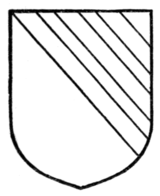of cadency. In the Gelre Armorial, in this particular coat the ribbon is made "engrailed," which is most unusual, and which does not appear to be the accepted form. In many of the Scottish matriculations of this Abernethy coat in which this riband occurs it is termed a "cost," doubtless another form of the word cottise.
When a bend or bendlets (or, in fact, any other charge) are raised above their natural position in the shield they are termed "enhanced" (Fig. 84). An instance of this occurs in the well-known coat of Byron, viz.: "Argent, three bendlets enhanced gules," and in the arms of Manchester, which were based upon this coat.
 Fig. 84.—Bendlets enhanced. |
 Fig. 85.—Pale. |
 Fig. 86.—Pale engrailed. |
When the field is composed of an even number of equal pieces divided by lines following the angle of a bend the field is blazoned "bendy" of so many (Fig. 58). In most cases it will be composed of six or eight pieces, but as there is no diminutive of "bendy," the number must always be stated.
THE PALE
The pale is a broad perpendicular band passing from the top of the escutcheon to the bottom (Fig. 85). Like all the other ordinaries, it is stated to contain the third part of the area of the field, and it is the only one which is at all frequently drawn in that proportion. But even with the pale, the most frequent occasion upon which this proportion is definitely given, this exaggerated width will be presently explained. The artistic latitude, however, permits the pale to be drawn of this proportion if this be convenient to the charges upon it.
Like the other ordinaries, the pale will be found varied by the different lines of partition (Figs. 86-94).
The single circumstance in which the pale is regularly drawn to contain a full third of the field by measurement is when the coat is "per fess and a pale counterchanged." This, it will be noticed, divides the shield into six equal portions (Fig. 95). The ease with which, by
